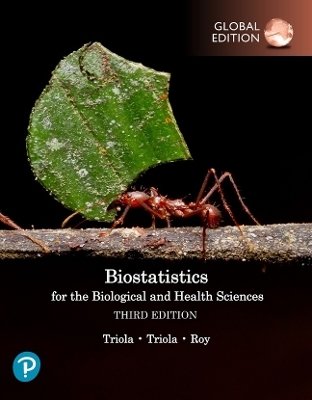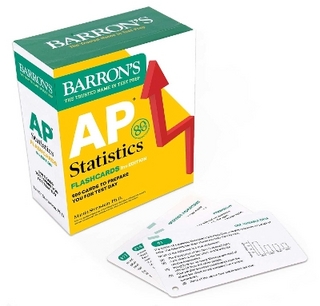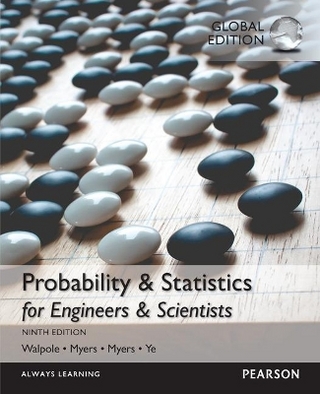
Probability and Statistical Inference
Pearson
978-0-321-58475-5 (ISBN)
- Titel erscheint in neuer Auflage
- Artikel merken
Written by two leading statisticians, this applied introduction to the mathematics of probability and statistics emphasizes the existence of variation in almost every process, and how the study of probability and statistics helps us understand this variation. Designed for students with a background in calculus, this book continues to reinforce basic mathematical concepts with numerous real-world examples and applications to illustrate the relevance of key concepts.
NEW TO THIS EDITION:
The included CD-ROM contains all of the data sets in a variety of formats for use with most statistical software packages. This disc also includes several applications of Minitab® and Maple™.
Historical vignettes at the end of each chapter outline the origin of the greatest accomplishments in the field of statistics, adding enrichment to the course.
Content updates
The first five chapters have been reorganized to cover a standard probability course with more real examples and exercises. These chapters are important for students wishing to pass the first actuarial exam, and cover the necessary material needed for students taking this course at the junior level.
Chapters 6 and 7 on estimation and tests of statistical hypotheses tie together confidence intervals and tests, including one-sided ones. There are separate chapters on nonparametric methods, Bayesian methods, and Quality Improvement.
Chapters 4 and 5 include a strong discussion on conditional distributions and functions of random variables, including Jacobians of transformations and the moment-generating technique. Approximations of distributions like the binomial and the Poisson with the normal can be found using the central limit theorem.
Chapter 8 (Nonparametric Methods) includes most of the standards tests such as those by Wilcoxon and also the use of order statistics in some distribution-free inferences.
Chapter 9 (Bayesian Methods) explains the use of the "Dutch book" to prove certain probability theorems.
Chapter 11 (Quality Improvement) stresses how important W. Edwards Deming's ideas are in understanding variation and how they apply to everyday life.
TABLE OF CONTENTS:
Preface
Prologue
1. Probability
1.1 Basic Concepts
1.2 Properties of Probability
1.3 Methods of Enumeration
1.4 Conditional Probability
1.5 Independent Events
1.6 Bayes's Theorem
2. Discrete Distributions
2.1 Random Variables of the Discrete Type
2.2 Mathematical Expectation
2.3 The Mean, Variance, and Standard Deviation
2.4 Bernoulli Trials and the Binomial Distribution
2.5 The Moment-Generating Function
2.6 The Poisson Distribution
3. Continuous Distributions
3.1 Continuous-Type Data
3.2 Exploratory Data Analysis
3.3 Random Variables of the Continuous Type
3.4 The Uniform and Exponential Distributions
3.5 The Gamma and Chi-Square Distributions
3.6 The Normal Distribution
3.7 Additional Models
4. Bivariate Distributions
4.1 Distributions of Two Random Variables
4.2 The Correlation Coefficient
4.3 Conditional Distributions
4.4 The Bivariate Normal Distribution
5. Distributions of Functions of Random Variables
5.1 Functions of One Random Variable
5.2 Transformations of Two Random Variables
5.3 Several Independent Random Variables
5.4 The Moment-Generating Function Technique
5.5 Random Functions Associated with Normal Distributions
5.6 The Central Limit Theorem
5.7 Approximations for Discrete Distributions
6. Estimation
6.1 Point Estimation
6.2 Confidence Intervals for Means
6.3 Confidence Intervals for Difference of Two Means
6.4 Confidence Intervals for Variances
6.5 Confidence Intervals for Proportions
6.6 Sample Size.
6.7 A Simple Regression Problem
6.8 More Regression
7. Tests of Statistical Hypotheses
7.1 Tests about Proportions
7.2 Tests about One Mean
7.3 Tests of the Equality of Two Means
7.4 Tests for Variances
7.5 One-Factor Analysis of Variance
7.6 Two-Factor Analysis of Variance
7.7 Tests Concerning Regression and Correlation
8. Nonparametric Methods
8.1 Chi-Square Goodness of Fit Tests
8.2 Contingency Tables
8.3 Order Statistics
8.4 Distribution-Free Confidence Intervals for Percentiles
8.5 The Wilcoxon Tests
8.6 Run Test and Test for Randomness
8.7 Kolmogorov-Smirnov Goodness of Fit Test
8.8 Resampling Methods
9. Bayesian Methods
9.1 Subjective Probability
9.2 Bayesian Estimation
9.3 More Bayesian Concepts
10. Some Theory
10.1 Sufficient Statistics
10.2 Power of a Statistical Test
10.3 Best Critical Regions
10.4 Likelihood Ratio Tests
10.5 Chebyshev's Inequality and Convergence in Probability
10.6 Limiting Moment-Generating Functions
10.7 Asymptotic Distributions of Maximum Likelihood Estimators
11. Quality Improvement Through Statistical Methods
11.1 Time Sequences
11.2 Statistical Quality Control
11.3 General Factorial and 2k Factorial Designs
11.4 Understanding Variation
A. Review of Selected Mathematical Techniques
A.1 Algebra of Sets
A.2 Mathematical Tools for the Hypergeometric Distribution
A.3 Limits
A.4 Infinite Series
A.5 Integration
A.6 Multivariate Calculus
B. References
C. Tables
D. Answers to Odd-Numbered Exercises
Robert V. Hogg, Professor Emeritus of Statistics at the University of Iowa since 2001, received his B.A. in mathematics at the University of Illinois and his M.S. and Ph.D. degrees in mathematics, specializing in actuarial sciences and statistics, from the University of Iowa. Known for his gift of humor and his passion for teaching, Hogg has had far-reaching influence in the field of statistics. Throughout his career, Hogg has played a major role in defining statistics as a unique academic field, and he almost literally "wrote the book" on the subject. He has written more than 70 research articles and co-authored four books including Introduction of Mathematical Statistics, 6th edition, with J. W. McKean and A.T. Craig, Applied Statistics for Engineers and Physical Scientists 3rd edtion with J. Ledolter and A Brief Course in Mathematical 1st edition with E.A. Tanis. His texts have become classroom standards used by hundreds of thousands of students Among the many awards he has received for distinction in teaching, Hogg has been honored at the national level (the Mathematical Association of America Award for Distinguished Teaching), the state level (the Governor's Science Medal for Teaching), and the university level (Collegiate Teaching Award). His important contributions to statistical research have been acknowledged by his election to fellowship standing in the ASA and the Institute of Mathematical Statistics. Elliot Tanis, Professor Emeritus of mathematics at Hope College, In addition to this text, received his M.S. and Ph.D. degrees from the University of Iowa. Tanis is the co-author of A Brief Course in Mathematical Statistics with R. Hogg and Probability and Statistics: Explorations with MAPLE 2nd edition with Z. Karian. He has authored over 30 publications on statistics and is a past chairman and governor of the Michigan MAA, which presented him with both its Distinguished Teaching and Distinguished Service Awards. He taught at Hope for 35 years and in 1989 received the HOPE Award (Hope's Outstanding Professor Educator) for his excellence in teaching. In addition to his academic interests, Dr. Tanis is also an avid tennis player and devoted Hope sports fan.
Preface
Prologue
1. Probability
1.1 Basic Concepts
1.2 Properties of Probability
1.3 Methods of Enumeration
1.4 Conditional Probability
1.5 Independent Events
1.6 Bayes's Theorem
2. Discrete Distributions
2.1 Random Variables of the Discrete Type
2.2 Mathematical Expectation
2.3 The Mean, Variance, and Standard Deviation
2.4 Bernoulli Trials and the Binomial Distribution
2.5 The Moment-Generating Function
2.6 The Poisson Distribution
3. Continuous Distributions
3.1 Continuous-Type Data
3.2 Exploratory Data Analysis
3.3 Random Variables of the Continuous Type
3.4 The Uniform and Exponential Distributions
3.5 The Gamma and Chi-Square Distributions
3.6 The Normal Distribution
3.7 Additional Models
4. Bivariate Distributions
4.1 Distributions of Two Random Variables
4.2 The Correlation Coefficient
4.3 Conditional Distributions
4.4 The Bivariate Normal Distribution
5. Distributions of Functions of Random Variables
5.1 Functions of One Random Variable
5.2 Transformations of Two Random Variables
5.3 Several Independent Random Variables
5.4 The Moment-Generating Function Technique
5.5 Random Functions Associated with Normal Distributions
5.6 The Central Limit Theorem
5.7 Approximations for Discrete Distributions
6. Estimation
6.1 Point Estimation
6.2 Confidence Intervals for Means
6.3 Confidence Intervals for Difference of Two Means
6.4 Confidence Intervals for Variances
6.5 Confidence Intervals for Proportions
6.6 Sample Size.
6.7 A Simple Regression Problem
6.8 More Regression
7. Tests of Statistical Hypotheses
7.1 Tests about Proportions
7.2 Tests about One Mean
7.3 Tests of the Equality of Two Means
7.4 Tests for Variances
7.5 One-Factor Analysis of Variance
7.6 Two-Factor Analysis of Variance
7.7 Tests Concerning Regression and Correlation
8. Nonparametric Methods
8.1 Chi-Square Goodness of Fit Tests
8.2 Contingency Tables
8.3 Order Statistics
8.4 Distribution-Free Confidence Intervals for Percentiles
8.5 The Wilcoxon Tests
8.6 Run Test and Test for Randomness
8.7 Kolmogorov-Smirnov Goodness of Fit Test
8.8 Resampling Methods
9. Bayesian Methods
9.1 Subjective Probability
9.2 Bayesian Estimation
9.3 More Bayesian Concepts
10. Some Theory
10.1 Sufficient Statistics
10.2 Power of a Statistical Test
10.3 Best Critical Regions
10.4 Likelihood Ratio Tests
10.5 Chebyshev's Inequality and Convergence in Probability
10.6 Limiting Moment-Generating Functions
10.7 Asymptotic Distributions of Maximum Likelihood Estimators
11. Quality Improvement Through Statistical Methods
11.1 Time Sequences
11.2 Statistical Quality Control
11.3 General Factorial and 2k Factorial Designs
11.4 Understanding Variation
A. Review of Selected Mathematical Techniques
A.1 Algebra of Sets
A.2 Mathematical Tools for the Hypergeometric Distribution
A.3 Limits
A.4 Infinite Series
A.5 Integration
A.6 Multivariate Calculus
B. References
C. Tables
D. Answers to Odd-Numbered Exercises
| Erscheint lt. Verlag | 26.3.2009 |
|---|---|
| Sprache | englisch |
| Maße | 203 x 254 mm |
| Gewicht | 1340 g |
| Themenwelt | Mathematik / Informatik ► Mathematik ► Statistik |
| Mathematik / Informatik ► Mathematik ► Wahrscheinlichkeit / Kombinatorik | |
| ISBN-10 | 0-321-58475-9 / 0321584759 |
| ISBN-13 | 978-0-321-58475-5 / 9780321584755 |
| Zustand | Neuware |
| Haben Sie eine Frage zum Produkt? |
aus dem Bereich



